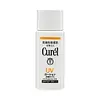What's inside
What's inside
 Key Ingredients
Key Ingredients

 Benefits
Benefits

 Concerns
Concerns

No concerns
 Ingredients Side-by-side
Ingredients Side-by-side

Butyl Methoxydibenzoylmethane 3%
UV AbsorberHomosalate 10%
Skin ConditioningEthylhexyl Salicylate 5%
UV AbsorberOctocrylene 5%
UV AbsorberWater
Skin ConditioningAlcohol Denat.
AntimicrobialLauryl Methacrylate/Sodium Methacrylate Crosspolymer
Diethylhexyl 2,6-Naphthalate
EmollientGlycerin
HumectantDextrin Palmitate
EmulsifyingDicaprylyl Ether
EmollientPhenoxyethanol
PreservativeAcrylates/C10-30 Alkyl Acrylate Crosspolymer
Emulsion StabilisingGlyceryl Behenate
EmollientPhenyl Trimethicone
Skin ConditioningParfum
MaskingCetyl Alcohol
EmollientSorbitan Distearate
EmollientLimonene
PerfumingSodium Hydroxide
BufferingStearoyl Glutamic Acid
CleansingArginine
MaskingLinalool
PerfumingGeraniol
PerfumingDisodium EDTA
Citral
PerfumingSodium Hyaluronate
HumectantButyl Methoxydibenzoylmethane 3%, Homosalate 10%, Ethylhexyl Salicylate 5%, Octocrylene 5%, Water, Alcohol Denat., Lauryl Methacrylate/Sodium Methacrylate Crosspolymer, Diethylhexyl 2,6-Naphthalate, Glycerin, Dextrin Palmitate, Dicaprylyl Ether, Phenoxyethanol, Acrylates/C10-30 Alkyl Acrylate Crosspolymer, Glyceryl Behenate, Phenyl Trimethicone, Parfum, Cetyl Alcohol, Sorbitan Distearate, Limonene, Sodium Hydroxide, Stearoyl Glutamic Acid, Arginine, Linalool, Geraniol, Disodium EDTA, Citral, Sodium Hyaluronate
Stearyl Glycyrrhetinate
Skin ConditioningDimethicone
EmollientWater
Skin ConditioningCyclopentasiloxane
EmollientCalcium Oxide
BufferingPalmitamine Oxide
CleansingZinc Oxide
Cosmetic ColorantPopulus Tremuloides Bark Extract
AntiseborrhoeicCyclomethicone
EmollientDimethicone/Methicone Copolymer
Butylene Glycol
HumectantSqualane
EmollientNeopentyl Glycol Dicaprate
EmollientCetyl-Pg Hydroxyethyl Decanamide
Skin ConditioningPolydiethylsiloxane
EmollientSilicon/Titanium/Cerium/Zinc Oxides
Glycerin
HumectantBis-Methoxypropylamido Isodocosane
EmollientEucalyptus Maculata Extract
Skin ConditioningPotassium Hydroxide
BufferingMethyl/Phenyl Polysilsesquioxane
Trisiloxane
Skin ConditioningHydrolyzed Oxidized Keratin
Skin ConditioningBarium/Calcium/Silicon/Titanium Oxide
Hydrobromic Acid
BufferingDextrin Palmitate
EmulsifyingCetyl Dimethicone
EmollientStearyl Glycyrrhetinate, Dimethicone, Water, Cyclopentasiloxane, Calcium Oxide, Palmitamine Oxide, Zinc Oxide, Populus Tremuloides Bark Extract, Cyclomethicone, Dimethicone/Methicone Copolymer, Butylene Glycol, Squalane, Neopentyl Glycol Dicaprate, Cetyl-Pg Hydroxyethyl Decanamide, Polydiethylsiloxane, Silicon/Titanium/Cerium/Zinc Oxides, Glycerin, Bis-Methoxypropylamido Isodocosane, Eucalyptus Maculata Extract, Potassium Hydroxide, Methyl/Phenyl Polysilsesquioxane, Trisiloxane, Hydrolyzed Oxidized Keratin, Barium/Calcium/Silicon/Titanium Oxide, Hydrobromic Acid, Dextrin Palmitate, Cetyl Dimethicone
 Reviews
Reviews

Ingredients Explained
These ingredients are found in both products.
Ingredients higher up in an ingredient list are typically present in a larger amount.
Dextrin Palmitate comes from the palmitic acid ester of Dextrin. It is used as an emulsifier and texture enhancer.
Emulsifiers help keep ingredients together. According to a manufacturer, dextrin palmitate helps create a low-viscosity gel texture.
Due to its fatty acid base, this ingredient is not fungal-acne safe.
Learn more about Dextrin PalmitateGlycerin is already naturally found in your skin. It helps moisturize and protect your skin.
A study from 2016 found glycerin to be more effective as a humectant than AHAs and hyaluronic acid.
As a humectant, it helps the skin stay hydrated by pulling moisture to your skin. The low molecular weight of glycerin allows it to pull moisture into the deeper layers of your skin.
Hydrated skin improves your skin barrier; Your skin barrier helps protect against irritants and bacteria.
Glycerin has also been found to have antimicrobial and antiviral properties. Due to these properties, glycerin is often used in wound and burn treatments.
In cosmetics, glycerin is usually derived from plants such as soybean or palm. However, it can also be sourced from animals, such as tallow or animal fat.
This ingredient is organic, colorless, odorless, and non-toxic.
Glycerin is the name for this ingredient in American English. British English uses Glycerol/Glycerine.
Learn more about GlycerinWater. It's the most common cosmetic ingredient of all. You'll usually see it at the top of ingredient lists, meaning that it makes up the largest part of the product.
So why is it so popular? Water most often acts as a solvent - this means that it helps dissolve other ingredients into the formulation.
You'll also recognize water as that liquid we all need to stay alive. If you see this, drink a glass of water. Stay hydrated!
Learn more about Water